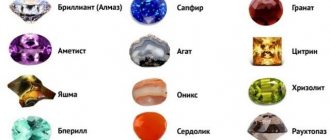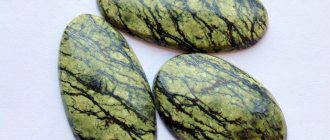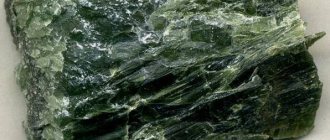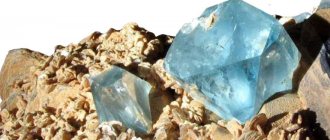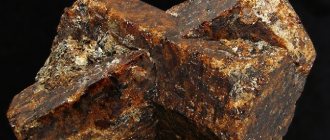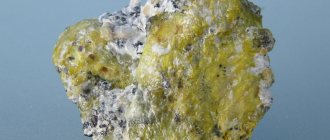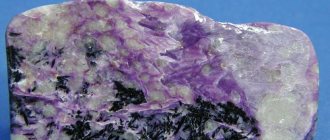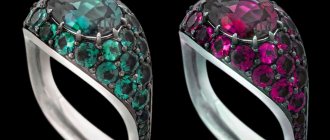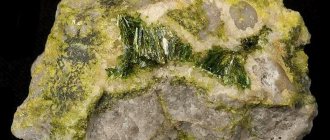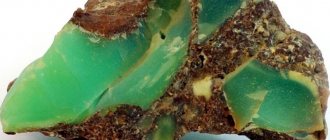/ List of stones / Description of the mineral Serpentine
0
3071
Article rating
The mineral Serpentine is a rock of the silicate class, which has its own varieties. Among them are aqueous silicates, which are represented by multilayer formations. Representatives of this group are called asbestos. The standard formula for Serpentine is Mg6[Si4O10][OH]8.
Description of the mineral Serpentine
What does a coil look like and what are its names?
This stone has a very memorable color: the color is bright green (sometimes there are yellow shades), and the pattern of veins resembles snake skin.
It is sometimes confused with malachite, but there are significant differences between them:
- the coil structure is opaque;
- fibers and leaf patterns are visible;
- special shade;
- the price is lower than that of malachite.
Some specimens resemble jade in appearance, but are inferior to it in physical and chemical properties, in particular in hardness.
Because of the unique color, such an interesting name for the mineral appeared in the Urals. It is also called Ural stone, moss stone, toligor, mountain flax, tow, Korean (or new) jade, apothecary stone.
The color of the serpentine was the reason for its scientific name - serpentine (“serpens” from Latin - snake). Sometimes it is identified with serpentinite, but these are different concepts:
- Serpentinite is a rock containing ornamental and semi-precious minerals.
- Serpentine is an ornamental stone.
Now the name “serpentine” for the mineral is considered obsolete and scientists assigned this term to the rock (serpentinite).
Origin of the name
The name of the stone can be translated from Latin as “serpentine” (from the word serpentipedi). The origin of the name “serpentine” is associated with the unusual color of the stone: frequent inclusions of whitish, gray and brown shades on a green background are reminiscent of shiny spots and scales on the skin of a rattlesnake, anaconda or snake. Despite the fact that in the 21st century geologists clearly distinguish between the names “coil” (serpentinite) and serpentine, most ordinary people call both minerals “coil”. Considering the fact that serpentinite belongs to the “serpentine” group, this cannot be considered an error.
Story
People have known about serpentine for a very long time. In China, archaeologists have found products made from it that are more than a thousand years old. These are beautiful decorations, as well as objects of worship. The Indians have also long used this mineral as a talisman and used it in making colored mosaics. In eastern countries, serpentine was often used as an imitation of jade and jadeite for inexpensive jewelry.
Europeans began processing this mineral in the mid-16th century . Initially, the coil was given importance as an ornamental stone, making furniture and interior items from it. It all looked very beautiful and expensive. Subsequently, the scope of application became wider. In Germany, for example, they began to make mortars and vessels for medicines from stone, since it was believed that they enhanced their effect and had antiseptic properties. That is why the name “apothecary stone” appeared.
Some peoples believed that the serpentine, so similar in color to the skin of a snake, was able to enhance the effect of antidotes.
For a long time, magical properties have been attributed to serpentine, legends have been made about its origin, and the main character in them is always a snake or, in the countries of the East, a dragon. These creatures evoke mixed feelings in people, which is reflected in their attitude towards the mineral.
One of the oldest legends is connected with a story from the Bible. According to this legend, the Serpent, having given Eve the fruit of knowledge, advised her to share it with Adam. Having bitten into an apple, Adam choked, a piece jumped out from coughing and turned into a green stone.
Residents of some European countries are sure that serpentine is the petrified tear of a huge Serpent. And in the south of Europe they believed that this was poison left by snakes during their “weddings.”
Ural legends tell of the Great Snake, who stands guard over gems and gold. In the spring, this snake sheds its skin, and its fragments become stones that retain the snake color.
In the Kunstkamera of St. Petersburg, among the unusual artifacts, there is a fireproof tablecloth made of mountain flax (that is, coil), which was given to Peter I by the Ural factory owner Demidov.
Biography of the mineral
The Olmecs (an ancient tribe located in the territory of modern Mexico) discovered spotted stones in pre-Columbian America. They created body jewelry from beautiful jade and paved city squares with polished bars of the mineral (for example, in La Venta).
Europeans (Germans, Swiss, Austrians) learned to use natural coil only in the seventeenth century, working mainly with local material, and in Russia the stone gained fame even later - after large deposits of green stone were discovered in the Ural Mountains (at the beginning of the eighteenth century) . Among the historical relics preserved from imperial times are palace serpentine sets in Gatchina and St. Petersburg.
Origin and physicochemical characteristics
The scientific name of serpentine is serpentine.
This is a group of minerals that are layered magnesium silicates with impurities. They do not form crystals; they are a dense mass. These stones are products of rock metamorphism. Chemical formula: X2-3 Si2 O5( OH)4, where X= Mg, Fe2+, Fe3+, Ni, Al, Zn, Mn .
Description of serpentines:
- The colors and patterns of minerals depend on impurities. The green range is quite wide - from pale to dark green. Sometimes the tones are yellowish, gray, brown and almost black. Occasionally there are blue and bluish-green shades.
- The luster of minerals is glassy, waxy, and greasy.
- Opaque, translucent at the edges.
- Hardness below average - 2,5–4.
- Density - 2.2–2.9 g /cm3 .
- There is no cleavage.
- The fracture is conchoidal.
- The fire resistance of serpentine is very high; it can withstand temperatures to 600 ° C.
Description and external signs
Serpentine belongs to a large group of layered silicate minerals, which includes magnesium-iron silicates of polymorphic modification. Serpentine is a rock that is primarily dark green in color and has a unique serpentine pattern, hence its second name, Serpentine. Often found with admixtures of garnet, pyroxene, and olivine. Typical impurities are carbonate, amphibole, talc, chromite.
The structure of the mineral is matted-fibrous, but fine-crystalline and cryptocrystalline masses are also found in nature. What do these gems look like? Crystals can be of various shades: yellow, dark green, spotted, dark, green with white streaks, bold, matte, glassy or pearlescent. Regarding transparency, Serpentine is a translucent, transparent or translucent mineral. Sometimes in nature there are specimens of white, dark red and bluish color. People call this stone moss, mountain flax, toligor, Korean jade.
Place of Birth
Serpentine is a fairly common mineral. Its deposits are found in various parts of the world:
- in Europe (Germany, Great Britain, Hungary, Italy, Sweden);
- in Asia (India, China, Tajikistan, Mongolia, Azerbaijan, Kazakhstan);
- in America (Cuba, USA);
- on the islands of New Zealand.
In Russia, serpentine began to be mined in the 18th century in the Urals (Shabrovskoye and Bazhenovskoye deposits). Then the mineral was found in Altai, the Caucasus, Orenburg region, and Yakutia.
Serpentine in rock composition
The mineral is formed as a result of low-temperature hydrothermal metamorphism of ultramafic rocks containing olivine and pyroxenes (dunites, peridotites). This process is called serpentinization, and the almost monomineral rocks formed during it are called serpentinites. They may have a small admixture of relict minerals such as olivine.
Also, dolomites (sedimentary carbonate rocks) exposed to hydrotherms can transform into serpentine.
Serpentinites usually occur in the form of irregular massifs and lens-shaped bodies, widespread throughout the world. On the territory of Russia, the Ural, Karelia, Northern Caucasus, Central and Southern Siberia, Transbaikalia, and Kamchatka Territory are very rich in serpentinite deposits.
Application
The coil is used in industry, jewelry, and arts and crafts.
Due to its high fire resistance, it is used in new technological developments, as well as in the creation of heat-resistant material (chrysolite-asbestos), from which equipment is made for workers in hot shops, employees of the Ministry of Emergency Situations and firefighters.
The crushed mineral is used in baths and placed in aquariums.
Decorative types are used for cladding panels, facades, fireplaces, and swimming pools.
Ornamental specimens - material for monuments, tabletops, watches, souvenirs, etc.
Jewelry is made from high-quality noble samples with patterns, shine, and glow.
Use of serpentines in industrial areas
The use of serpentines is also quite widespread in technical industries.
The mineral chrysotile asbestos, for example, is used in the manufacture of fire-resistant fabrics and heat-insulating structures. In addition, it is valued as an alkali-resistant material. The nepuite mentioned above and other nickel-bearing serpentines are nickel ores. Some minerals of this group with a high content of magnesium can serve in the chemical industry as important raw materials for the production of this metal.
Serpentines with a high degree of hydration are used in the organization of biological protection of nuclear reactors as backfill and concrete fillers. Minerals depleted in iron with a high content of magnesium and silicic acid are used as raw materials for adsorbents used in water and gas purification.
Massifs of serpentinized rocks are of interest from the point of view of prospecting and exploration of accompanying deposits of such valuable minerals as diamonds, platinum and chromite ores.
Varieties and colors
The serpentine mineral has a range of green tones - from olive to very dark. If there is a pattern, it looks like veins or spots.
There are many varieties of serpentine in nature, the three main ones are:
- Attigorite is a yellow or green agglomerate with a glassy or matte sheen.
- Chrysotile is a translucent mineral with a silky shine; color green, whitish-green, white or golden; can easily be divided into flexible thin fibers. Colloquially known as asbestos.
- Lizardine is green, greenish-blue, dark green, white or yellow. The gloss is matte and greasy. It shines through at the edges.
Other varieties include:
- Bowenite (tangevaite) is a pale green mineral, sometimes with a yellow or blue tint. Externally it resembles jade. It differs from other types in its high hardness.
- Verdanite - the background of the stone is swamp green, with dark veins on it.
- Vernantite is dark green with shiny calcite veins.
- Williamsite is a green specimen with a blue tint and a small number of small black spots. Tones can be both dark and light.
- Nigrescite is an example of the darkest color - from deep green to almost black.
- Retinolite - green and sand tones, resinous shine.
- Ricolite is bright green, sometimes pale yellow or gray with clear stripes.
Other serpentine minerals are rare in nature.
Noble types of coils, distinguished by a beautiful pattern, silky shine, and glow, include:
- Ophite (noble serpentine) is a slightly translucent stone without dark inclusions, with a uniform green color. Can be confused with jade, but ophite is twice as soft.
- Noble serpentine (in the Urals called moss fly) - with an even light olive or pale light green color; Sometimes there are small dark inclusions.
These two varieties are used as ornamental stone.
Serpentine classification
There are many varieties of this stone and they all differ in color, pattern and texture. The main and most popular varieties of the mineral are considered to be:
- Chrysotiles. They got their name from two Greek words “chrysos”, which means gold, and “tilos” - fiber. They have a leafy or fibrous structure and high strength. They belong to magnesium phyllosilicates. They have found their application in production (asbestos), they are an integral part of heat-insulating non-combustible materials and textiles, various fillers in the production of plastics and cement.
- Antigorites. The origin of their name is closely related to the mountains of Italy, where they were first found. They can be brown and gray, yellow and green in color. It is mainly used as an ornamental stone for the manufacture of decorative items and design works. High quality specimens are highly valued by jewelers and are used to create jewelry. Processing occurs in the form of a cabochon. Particularly beautiful representatives are cut and inserted into various jewelry: bracelets, rings, pendants. Picrolite is one of the translucent forms of antigorite, has a cat's eye effect.
Among the Serpentines there are also:
- Ophites, the so-called noble serpentines, which have lighter tones, translucency, and a waxy sheen. Color range: from yellowish to greenish. If we are talking about bluish or bright green specimens, then they are called Williamsites. There are white-green specimens. The color can be uniform or with black splashes. Somewhat reminiscent of jade;
- Bowenites are so called because the name of their discoverer was George Bowen. Although at the very beginning he confused them with jades, he later found clear differences between these two minerals. Sometimes Bowenites are called Bowen jades, since they are similar in appearance. These stones are the hardest of the entire Serpentine group, their cost is comparable to other precious stones. People sometimes call them precious serpentines. This gem is highly polished, so it is very popular among carvers. Officially, since 1966, this stone has been considered the symbol of Rhode Island;
- verdantites are a rather beautiful natural stone of dark green color with calcite veins;
- ophicalcite (or serpentine marble) - a coil covered with dolomite or calcite spots;
- satepites have a cat's eye effect, shimmer in the light, and have a fibrous structure;
- lizardites. They were first discovered in Lizard (England), where the name came from. They are scaly, fine-grained, transparent crystals with green, yellow, and white colors. They are most used in the creation of household items and souvenirs;
- ricolites - striped specimens of green, yellow and gray colors with beautiful stripes;
- Porcellophytes are similar in appearance to porcelain and have an opaque green tint.
If we take into account the mineral composition, then serpentine varieties include chrysotile, antigorite, garnet, and bronzite coils.
Chemical composition
The chemical formula of Serpentine looks like this: Mg6[Si4O10][OH]8 or 3MgO*2SiO2*2H2O. This mineral contains magnesium (42%), silicon oxide (45%), water (17%). In small quantities there are impurities such as nickel, iron, aluminum. The presence of natural inclusions in the form of iron or magnetite grains contributes to the formation of a magnetic property in the mineral. When a stone gets into hydrochloric or sulfuric acid, it easily dissolves.
| Basic physical properties | |
| singonia | monoclinic |
| Hardness | 2,5 – 3,5 |
| Cleavage | perfect |
| Density g/cm3 | 2.6 |
| Specific gravity | 2,5 – 2,7 |
| IMA class | silicates |
| Selection form | masses of leafy (antigorite) or fibrous (chrysolite) type, cryptocrystalline aggregates |
| Kink | uneven, conchoidal, smooth |
| Fragility | Yes |
| Softness | significant |
Mineral deposits
The process of formation of Serpentine is associated with the metamorphosing effect on igneous rocks, the main components of which are pyroxenes and olivines, as well as water that rises from magma chambers and cools the rocks. Olivine and pyroxene-containing rocks, after weathering and interaction with waters rich in silica and carbon dioxide, give rise to Serpentine. But if Serpentine is constantly exposed to carbon dioxide water, then over time it will collapse and become chalcedony, limonite, opal and magnesite.
Serpentine deposits are found where rocks rich in asbestos are mined. These are the Urals, the North Caucasus, Transbaikalia. They know about these minerals in Kazakhstan, Afghanistan and the USA. But there are other places on the planet where this mineral is mined. This applies to Germany, Canada, Italy, China, New Zealand, India, Mongolia, Colombia. Great Britain, Tajikistan, Armenia and Azerbaijan can also boast of industrial production volumes.
Medicinal properties
It is not for nothing that the serpentine was called an apothecary stone - it is held in special esteem by folk healers and healers.
Official medicine recognizes that the effect of drugs is enhanced if these drugs are stored in a serpentine vessel. The dosage is reduced, but the effectiveness remains the same.
Modern healers use the serpentine as a healing agent, recognizing its following abilities:
- clears the room of bad energy;
- adds strength and endurance during physical, psychological, emotional overloads;
- reduces nervousness and excessive emotionality;
- removes waste and toxins from the body;
- has a beneficial effect on the immune system.
It is believed that the coil, starting to heat up, predicts the onset of illness.
Jewelry with serpentine is a therapeutic and prophylactic agent:
- Necklaces and beads are useful for gastrointestinal diseases and colds.
- Bracelets, rings - help with bruises, cuts, dislocations, fractures.
- Earrings are beneficial for hypertension, migraines, and headaches.
- Rosary beads have a beneficial effect on the nervous system.
The healing power is enhanced if the coil is set in cupronickel or silver.
Magic properties
The serpentine is a unique talisman, the essence of which comes down to all kinds of help to its owner. But it is not suitable for everyone and has an ambiguous meaning for a person.
Positive magical abilities of the serpentine:
- Cleanses both the owner and the entire space around him from unfavorable energy. In a box made of this mineral, all jewelry will be reliably protected from negative energy.
- Removes curses from a person: damage, evil eye.
- Helps the owner in self-knowledge, in moving forward in the field of creativity, scientific research, and self-education.
- Helps increase physical endurance, develop logical thinking, intuition, and imagination.
- With its help, memory is improved and the assimilation of information is accelerated.
- Makes its owner wiser in making important decisions.
- Gives strength in difficult situations, protects from dangers.
It is worth noting that this magic stone only helps active, purposeful people who treat it with respect and give proper care.
Some, remembering the biblical Serpent-tempter, believe that the serpentine can also be insidious, distracting the owner from his true goals and encouraging vicious inclinations and actions. It is believed that in this way the pebble tests a person’s strength of spirit and strength of character, and if he overcomes the challenges, it will become his faithful assistant. The coil will give peace of mind, calmness, courage, and awaken dormant talents.
If the owner is used to lying and does not want to be sincere and honest, the stone can attract a lot of minor troubles to him.
Serpentine is a very faithful, but capricious mineral. It serves only the first owner, so it cannot be given as a gift (the stone will regard this as betrayal and, since the power of its magic is very great, it can take revenge from a distance). But you can inherit a coil from a blood relative.
The coil is able to protect the house from various misfortunes (thieves, natural disasters) and family conflicts.
In order for the stone to retain its magical power, it should be worn only a couple of times a week, and not given to other people.
Since the coil tends to absorb negativity, it should be cleaned from time to time (especially after “going out” in decoration) of bad energy under running water.
Who is suitable according to their zodiac sign?
Astrologers warn that the serpentine sign does not suit everyone’s horoscope. As a zodiac talisman or amulet, this mineral is recommended to be worn by active people who are ready to overcome difficulties and trials on the way to their goals - it will be a faithful assistant to them. For people who lack initiative, are weak-willed, and go with the flow, wearing a stone is contraindicated, as it can lead them to degradation.
The coil can choose its owner itself - if you like the pebble and subconsciously don’t want to let it go, it means there is energetic compatibility.
The stone is neutral towards many zodiac signs, while towards others it has obvious sympathy or antipathy. Serpentine is most compatible with Capricorn and Virgo .
- Capricorn will find a reliable ally in this stone, who will give confidence that all obstacles can be overcome and will help increase physical strength, agility, and endurance. A person’s hidden reserves of the body are mobilized, and an interest in physical education and active recreation appears. This mineral is ideal for athletes and people engaged in physical labor.
- Virgo will feel creative inspiration from communicating with the serpentine and discover new abilities in herself. Suspiciousness and apathy will disappear, and instead, harmony will appear in the soul and in relationships with people around you. Intuition and craving for self-improvement and spiritual development will become more acute.
- Aries, under the influence of the stone, will become calmer and more balanced, will not allow himself to be rude towards others, will be able to recognize liars and avoid communicating with them.
- Taurus will feel a desire to trust people more, will become more open, but, at the same time, will understand who not to communicate with. The stone will ward off unnecessary risks and help improve health.
- Gemini , who wear the serpentine from time to time, will feel confident in their abilities and, most likely, will reconsider their lifestyle and decide on new things and acquaintances.
- Leo is a naturally strong sign, but the stone can make his character even stronger. Increased stamina and confidence. By becoming more organized and purposeful, a person will be able to do several things at the same time.
- Libra will learn to make decisions only after thoroughly thinking about the problem. Frequently changing opinions about many things will become more stable.
- Scorpio will feel determined to implement new major projects that seemed beyond his capabilities.
- Sagittarius will become lucky; the serpentine talisman will bring him success both in business and in his personal life.
- Aquarius , with the help of the coil, will discover new talents and will try to develop and realize them.
It is not recommended for all of the listed zodiac signs to wear jewelry with a coil every day; it is enough to wear them twice a week . If the pebble is in a bag or pocket, you can carry it there more often, but you still need to take breaks. There will be no harm from a decorative item decorating the interior; on the contrary, household members will treat each other kindly.
For overly emotional zodiac signs - Cancer and Pisces - astrologers do not recommend wearing a serpentine, as it can, testing them with temptations, push them to internal disharmony, depression, and even possible degradation in ethical terms.
Pisces and Cancer, adularia or labradorite are more suitable as a talisman or amulet.
In addition, lucky stones for Pisces are amethyst, rose quartz, opal, jasper, and spinel. Cancer should buy agate, cat's eye, pearl, emerald, chrysoprase or aventurine as an amulet or talisman.
How to wear and care
Serpentine is a stone of very powerful energy, so people with strong energy can also wear it constantly. Others are advised to wear serpentine jewelry 2-3 times a week .
If apathy or depression appears, jewelry should be removed, even if the stone matches your zodiac sign.
The coil absorbs mental negativity, so periodically it needs to be freed from bad energy. for about 15 minutes - and it is again ready to cleanse the space around itself. The wet pebble should be blotted with a soft cloth (do not rub!) or simply left to dry on a napkin.
After this, you can charge the mineral with energy: place it under the sun or, on a full moon, under moonlight. It is imperative to ensure that the stone does not get too hot under the sun's rays.
If other jewelry is stored in a coil box, they will also be cleansed of bad energy (but the box itself (empty) should also be placed under running water from time to time).
The contaminated stone is washed with a soft cloth in a soapy solution and rinsed.
The coil must be protected from mechanical influences so that it does not crack or get scratched. Store jewelry conveniently and safely in jewelry cases and bags.
Stone care
It is worth constantly remembering the softness of the mineral, so it must be protected from any mechanical damage. It should not be stored together with other precious stones. It is necessary to take care of an individual box and a soft base. There is no need to expose the stone to open sunlight and keep the gem in a room with excessive humidity. If there is a need to clean it, you should use warm running water. Under no circumstances should you use cleaning agents.
How to distinguish from a fake
Serpentine is a fairly common and inexpensive mineral, but it is still counterfeited. It’s easy to determine whether the mineral in front of you is a natural one or a plastic fake:
- Take a pebble in your hand. The real one is cool, but if it quickly becomes warm, this indicates a fake. Some people feel a slight tingling sensation in their fingers from the coil.
- Study the drawing. In a real mineral, it is disordered; such chaotic spots, inclusions and stripes are difficult to reproduce. The design of the fake seems to be “sleek”, it is clear that it is handmade.
- Estimate weight. The stone is heavier than the polymer copy.
To check the authenticity, you cannot scratch the sample, since the coil is a fairly soft mineral and can easily be damaged by a sharp object.
Best time to buy
Experts in esotericism recommend buying serpentine on the 18th lunar day - during this period its energy is minimal. If you immediately hold it in your left hand, compatibility with the stone will increase.
You should not use it right away - you need to wait for half a month for it to recharge with energy. During this time, you need to sometimes pick him up and communicate.
On the 4th lunar day, the stone exhibits a peak of activity, and at this time you need to start using it, putting on jewelry with your right hand.
Price
Serpentine is not a rare mineral, so it is inexpensive. Unprocessed stone costs from 12 to 65 rubles per 1 kg .
The cost of a decorative item made of serpentine is determined by the size of the product and the degree of finishing. The box, for example, has a price range from 550 to 6500 rubles .
The price of jewelry is determined according to the following parameters:
- variety;
- quality and type of processing;
- frame cost.
Most often, the coil is set with a silver-plated jewelry alloy.
Approximate prices for serpentine jewelry:
- earrings - 100–800 rub. ;
- bracelet - 300–800 rub. ;
- rings - 400–800 rub. ;
- nickel silver sets (earrings plus beads) - from 700 rubles. ;
- beads - from 1,100 rubles. ;
- pyramid (50 x 50 mm) - 186 rub. ;
- cabochon (50 x 33 x 5 mm) - 190 rub. ;
- writing instrument “Cube” - RUB 12,779. ;
- chess — 18,920 rub.
